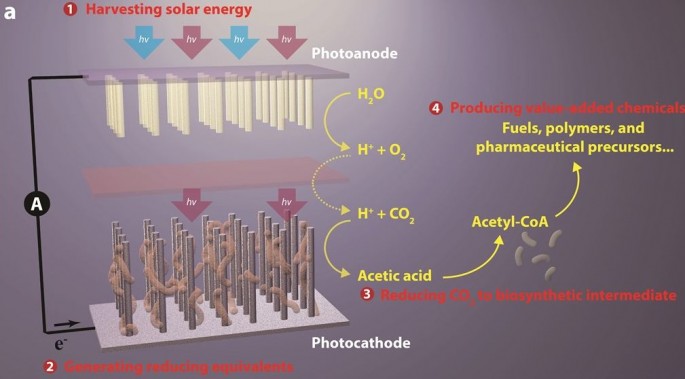A potential breakthrough in artificial photosynthesis captures carbon dioxide before this is released into the atmosphere and transforms this greenhouse gas into a vast array of sustainable products including life saving medicines and liquid fuels.
This has been made possible by a hybrid system of semiconducting nanowires and bacteria that mimics the natural photosynthetic process developed by scientists with the U.S. Department of Energy Lawrence Berkeley National Laboratory (Berkeley Lab) and the University of California (UC) Berkeley.
"Our system has the potential to fundamentally change the chemical and oil industry in that we can produce chemicals and fuels in a totally renewable way, rather than extracting them from deep below the ground," said Peidong Yang, a chemist with Berkeley Lab's Materials Sciences Division and one of the leaders of this study.
"We believe our system is a revolutionary leap forward in the field of artificial photosynthesis".
This new artificial photosynthetic system developed by the Berkeley researchers synthesizes the combination of carbon dioxide and water into acetate, the most common building block for biosynthesis.
The yields of target chemical molecules produced from the acetate were very encouraging. This was as high as 26 percent for butanol, a fuel comparable to gasoline; 25 percent for amorphadiene, a precursor to the antimaleria drug artemisinin and 52 percent for the renewable and biodegradable plastic PHB (Polyhydroxybutyrate). Improved results are anticipated with further refinements of the technology.
The system starts with an "artificial forest" of nanowire heterostructures consisting of silicon and titanium oxide nanowires developed earlier by Yang and his research group.
"Our artificial forest is similar to the chloroplasts in green plants," said Yang.
"When sunlight is absorbed, photo-excited electron hole pairs are generated in the silicon and titanium oxide nanowires, which absorb different regions of the solar spectrum. The photo-generated electrons in the silicon will be passed onto bacteria for the CO2 reduction while the photo-generated holes in the titanium oxide split water molecules to make oxygen."
Once the forest of nanowire arrays is established, it is populated with microbial populations that produce enzymes known to selectively catalyze the reduction of carbon dioxide.
The Berkeley team used Sporomusa ovata, an anaerobic bacterium that readily accepts electrons directly from the surrounding environment and uses them to reduce carbon dioxide.
S. ovata is considered an exceptional carbon dioxide catalyst since it makes acetate, a versatile chemical intermediate that can be used to manufacture a diverse array of useful chemicals. The researchers were able to uniformly populate their nanowire array with S. ovata using buffered brackish water with trace vitamins as the only organic component.
Once the carbon dioxide has been reduced by S. ovata to acetate (or some other biosynthetic intermediate), genetically engineered E.coli are used to synthesize targeted chemical products. To improve the yields of targeted chemical products, the S. ovata and E.coli were kept separate for this study.
In the future, these two activities - catalyzing and synthesizing - could be combined into a single step process.
"We are currently working on our second generation system which has a solar-to-chemical conversion efficiency of three-percent," said Yang. "Once we can reach a conversion efficiency of 10 percent in a cost effective manner, the technology should be commercially viable."
The paper published in the journal Nano Letters is titled "Nanowire-bacteria hybrids for unassisted solar carbon dioxide fixation to value-added chemicals." The other corresponding authors and leaders of this research are chemists Christopher Chang and Michelle Chang.



























